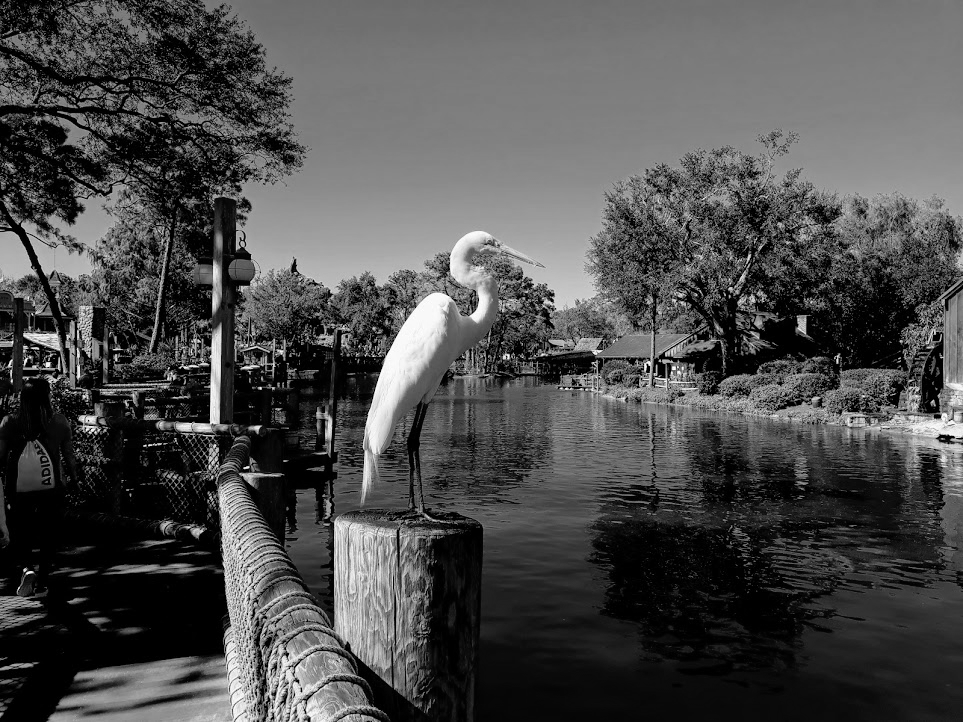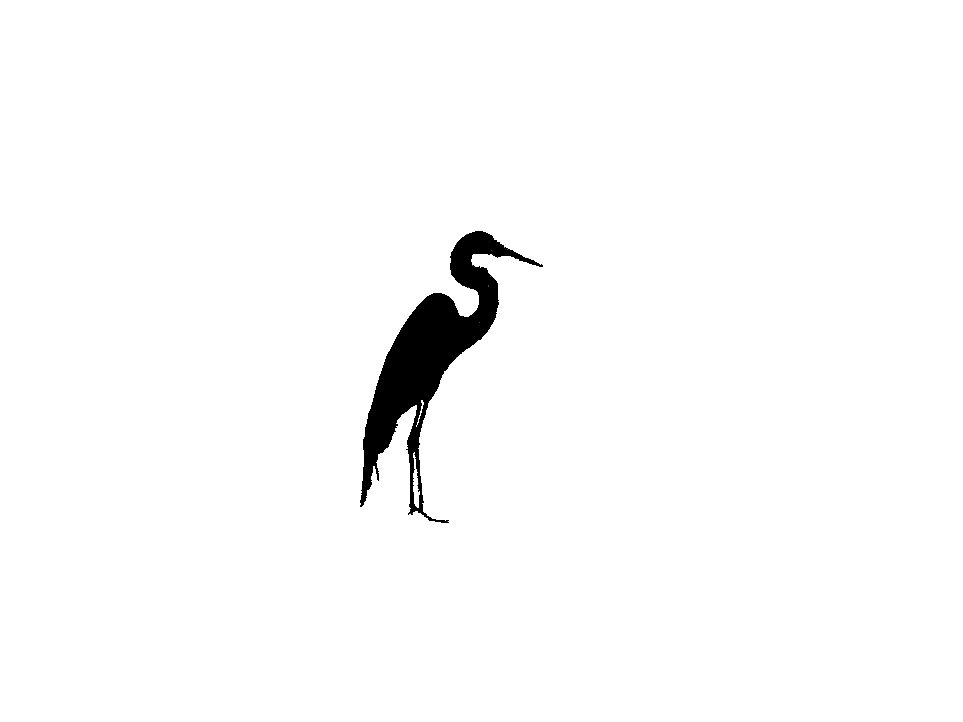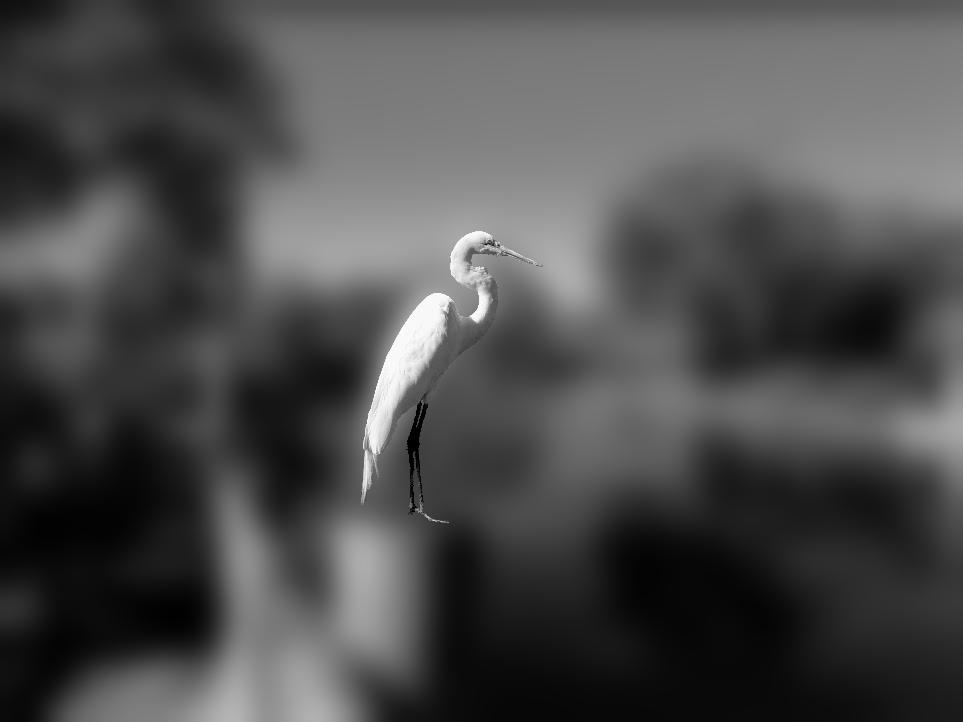Overview
Recursive Gaussian Filter is a low-pass IIR (infinite impulse response) Gaussian filter that smooths out the image by doing a series interconnection of low-order causal and anti-causal recursive filters. It approximates well wide support Gaussian filters, i.e. the ones with bigger standard deviations (sigma), while providing superior performance than direct-convolution Gaussian Filter. It has the advantage of filtering images at the same computing time no matter how large the sigma, as it does not have nor depend on the kernel support size.
It supports only one mode of operation:
- User provides filter standard deviation (sigma).
The image below shows an usage example. The entire input image is blurred with a big sigma using Recursive Gaussian Filter to serve as background, while a mask is used to segment out and preserve the heron in the middle of it.
| Input and mask | Gaussian sigma | Output |
|---|---|---|
  | \[ \sigma=17 \] |  |
Implementation
Recursive Gaussian filter is implemented as a sequence of forward-direction (causal) filter and back-direction (anti-causal) filter on rows and columns of an input image. To better understand them, let us first define linear time-invariant (LTI) filter as:
\[ \sum_{i=-r}^{r} a_i z[k-i] = \sum_{i=-s}^{s} b_i w[k-i] \]
The \(a_i\) and \(b_i\) are filter design parameters. The \(w[k]\) and \(z[k]\) are input and output signals, respectively. This LTI filter can be decomposed into a convolution pass and a causal and anti-causal combination of recursive filter passes:
\[ x[k] = \sum_{i=-s}^{s} c_i w[k-i] \]
\[ y[k] = x[k] - \sum_{i=1}^{r} d_i y[k-i] \]
\[ z[k] = y[k] - \sum_{i=1}^{r} e_i z[k-i] \]
The convolution has a finite impulse response (FIR) given by the \(c_i\) coefficients, and \(s\) is the convolution kernel support. Moreover, the recursive filters have an infinite impulse response (IIR) given by the \(d_i\) and \(e_i\) coefficients, and \(r\) is the filter order. The \(x[k]\) and \(y[k]\) are intermediary output signals of the FIR and IIR, respectively. This process can be extended from 1D signals to 2D images by independently filtering all columns and then all resulting rows.
Instead of direct convolution, a third-order recursive filter can be used to approximate Gaussian filtering, operating in linear time independent of the standard deviation. They are the best alternative in terms of performance, quality and simplicity, especially for wide support filters. In the example above, a direct convolution kernel of \(101x101\) in support size is needed to accomodate the specified \(sigma=17\) and obtain the same blur effect.
The implementation overlaps causal-anticausal processing with row-column processing. Overlapping works similar as fusion, but in a deeper, intra-stage algorithmic level. For more information, see [1].
C API functions
For list of limitations, constraints and backends that implements the algorithm, consult reference documentation of the following functions:
| Function | Description |
|---|---|
| vpiCreateRecursiveGaussianFilter | Creates payload for vpiSubmitRecursiveGaussianFilter. |
| vpiSubmitRecursiveGaussianFilter | Runs a Recursive Gaussian Filter over an image. |
Usage
Language:- Import VPI module import vpi
- Use Recursive Gaussian Filter to blur the input image with \(\sigma=17\), using REFLECT boundary condition in the CUDA backend. Input and output are VPI images. with vpi.Backend.CUDA:output = input.recursive_gaussian_filter(17, border=vpi.Border.REFLECT)
- Initialization phase
- Include the header that defines the Recursive Gaussian filter function. #include <vpi/algo/RecursiveGaussianFilter.h>Declares functions that implement the Recursive Gaussian Filter algorithm.
- Define the input image object. VPIImage input = /*...*/;
- Create the output image. It gets its dimensions and format from the input image. int32_t w, h;vpiImageGetSize(input, &w, &h);VPIImageFormat type;vpiImageGetFormat(input, &type);VPIImage output;vpiImageCreate(w, h, type, 0, &output);VPIStatus vpiImageGetFormat(VPIImage img, VPIImageFormat *format)Get the image format.VPIStatus vpiImageCreate(int32_t width, int32_t height, VPIImageFormat fmt, uint64_t flags, VPIImage *img)Create an empty image instance with the specified flags.VPIStatus vpiImageGetSize(VPIImage img, int32_t *width, int32_t *height)Get the image dimensions in pixels.
- Create the stream where the algorithm will be submitted for execution. VPIStream stream;vpiStreamCreate(0, &stream);VPIStatus vpiStreamCreate(uint64_t flags, VPIStream *stream)Create a stream instance.
- Create the Recursive Gaussian Filter payload. The width and height are the maximum image size that can be used by the submit Recursive Gaussian Filter. VPIPayload payload;vpiCreateRecursiveGaussianFilter(VPI_BACKEND_CUDA, w, h, &payload);VPIStatus vpiCreateRecursiveGaussianFilter(uint64_t backends, int32_t maxWidth, int32_t maxHeight, VPIPayload *payload)Creates payload for vpiSubmitRecursiveGaussianFilter.
- Include the header that defines the Recursive Gaussian filter function.
- Processing phase
- Submit the Recursive Gaussian Filter algorithm to the stream along with other parameters. It will be executed by the CUDA backend. It defines a Gaussian filter with \(\sigma=17\), along with reflect-border extension. vpiSubmitRecursiveGaussianFilter(stream, VPI_BACKEND_CUDA, payload, input, output, 17, 17, VPI_BORDER_REFLECT);VPIStatus vpiSubmitRecursiveGaussianFilter(VPIStream stream, uint64_t backend, VPIPayload payload, VPIImage input, VPIImage output, float sigmaX, float sigmaY, VPIBorderExtension border)Runs a Recursive Gaussian Filter over an image.
- Optionally, wait until the processing is done. vpiStreamSync(stream);VPIStatus vpiStreamSync(VPIStream stream)Blocks the calling thread until all submitted commands in this stream queue are done (queue is empty)...
- Submit the Recursive Gaussian Filter algorithm to the stream along with other parameters. It will be executed by the CUDA backend. It defines a Gaussian filter with \(\sigma=17\), along with reflect-border extension.
- Cleanup phase
- Free resources held by the stream, input and output images and the algorithm payload. vpiStreamDestroy(stream);vpiImageDestroy(input);vpiImageDestroy(output);vpiPayloadDestroy(payload);void vpiPayloadDestroy(VPIPayload payload)Deallocates the payload object and all associated resources.void vpiStreamDestroy(VPIStream stream)Destroy a stream instance and deallocate all HW resources.
- Free resources held by the stream, input and output images and the algorithm payload.
For more information, see Recursive Gaussian Filter in the "C API Reference" section of VPI - Vision Programming Interface.
Performance
For information on how to use the performance table below, see Algorithm Performance Tables.
Before comparing measurements, consult Comparing Algorithm Elapsed Times.
For further information on how performance was benchmarked, see Performance Benchmark.